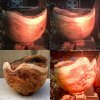I do prefer a shear scrape to a scrape for a finish cut on just about everything. Primary reason is the high shear angle is better at gently lifting the fibers as they are cut compared to a scraping cut which pulls, and needs the other fibers around it for support for a cleaner cut. This is probably why end grain cuts cleaner with scrapers than flat grain. A negative rake scraper is still a scraping cut so there is still some very minimal tear out going on. The point is that we can get tear out to minimal levels which easily sand out with the NRS, but not totally get rid of it. Same is true with any tool on bowl grain orientation. You may not be able to see it, but you can feel it with your hand if you rub in forward and reverse on the bowls, and yes, I am peculiar/particular in this respect. Watched a Dale Larson demo, and after examining his 'no tear out' bowl, I could feel a teeny tiny bit. It is more difficult to shear scrape the inside of a bowl. I don't know if bevel angles are critical to fine shear scraping. I use my standard 70 degree bevel scrapers on my bowls, and prefer the 600 or 1000 grit burrs.
I have burnished a burr on my 30 and 35 degree NRS's, and don't really know that it made any difference. My burnishing may be a contributing factor. There is an art to burnishing burrs, and I don't have a carbide burnishing tool, just the standard card scraper burnishing tools. I know the key is with a 70 degree bevel, you want your burnisher at 75 degrees or so, and very minimal pressure is needed to turn the burr, and yes, even on HSS. I have one myrtle plate that I will have in Atlanta that gave me fits, and I could only get a clean surface on the inside with a NRS. Prior to burnishing, the bevels need to be honed, and even with the 1000 grit wheel, I can feel a burr. (a spoon carving friend who does his stuff with an 'off the tool' finish was complaining about the burr on his carving knives which I couldn't feel, and I wasn't using my guitar string fingers either). I have burnished the burr down, then back up, which is common on card scrapers, and don't think I got nearly as good of an edge as I did with the fresh from the grinder burr. Again here, the wheel you use makes a big difference, finer wheel = finer burr, and CBN is far better than standard wheels. I haven't used the upside down sharpened burr very much. Critical to getting the clean surface was very very light pressure, and fresh edge about every 5 seconds. That is one point that Stuart makes. You can still feel a burr, and it will cut, but it leaves a rougher surface. Amazing what a fresh edge will accomplish. Some times I think Stuart tolerates me because I ask questions that no one else asks...
In my chat with Tom, he has done some micro photography on edges, and if I can, I would like to get him to do that on the 600 and 1000 grit burrs.
Still so much to discover.
Emilliano, I will check out Doug's NRS's at the Symposium, as I haven't seen them yet. Before sharpening, if the grinds are not the same on both sides, I prefer to remove the old burr first, which for me is either honing, or taking a hand burnishing tool to them to turn the burr down, then sharpen a fresh one onto it. Hard wood will cut cleaner than soft wood, and the burr is so tiny that it really doesn't cut long.
robo hippy







